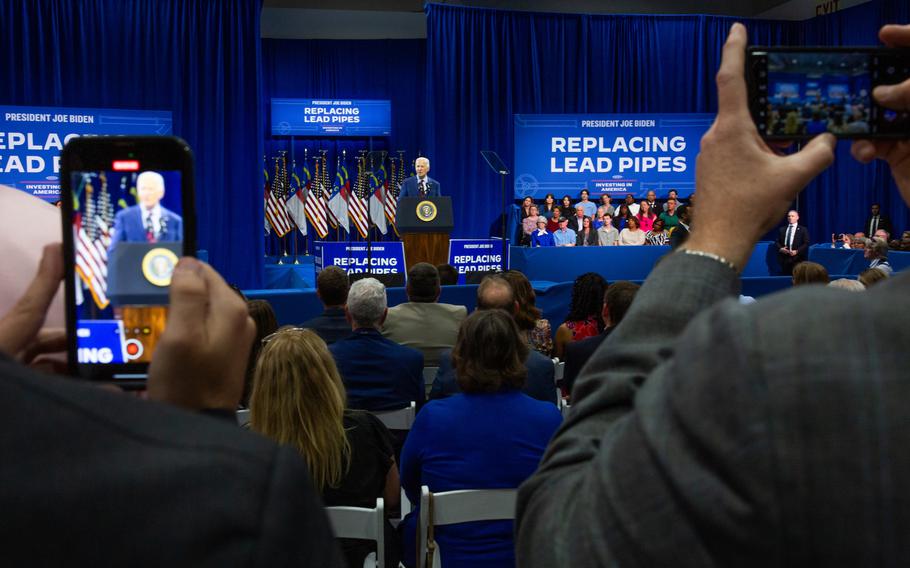U.S.
White House announces new money to fight lead contamination in school water
The Washington Post August 22, 2024

President Joe Biden discusses his commitment to removing lead pipes and ensuring clean drinking water throughout the country during an event at the Wilmington Convention Center in Wilmington, N.C., on May 2. (Madeline Gray/The Washington Post)
The White House on Thursday announced $26 million in new funding to test for and remove lead from water in schools and child care facilities, two months ahead of plans to publish a new rule requiring such testing at elementary and middle schools.
While there is no national requirement to test for lead in school water, states and localities that have chosen to test often find it. Lead in schools is frequently caused not by lead service lines, which are narrow pipes that serve households and small businesses, but by lead-laced plumbing and fixtures.
“We are making sure kids have a safe and healthy environment to learn and to grow and making sure everyone in this country can turn on the tap and drink clean water,” said Natalie Quillian, a White House deputy chief of staff.
There is no safe level of lead exposure, according to health organizations such as the American Academy of Pediatrics. Drinking lead contaminated with water as a child can lead to developmental disabilities, behavioral issues and attention deficit disorders.
The new money is one of several buckets of funding addressing the ongoing problem of lead contamination in drinking water around the country. All 50 states and U.S. territories will be able to apply for the funding over the coming year.
Last year, the Environmental Protection Agency announced $58 million in lead testing grants for fiscal year 2022 and 2023.
The Biden administration has also been doling out $3 billion annually under the bipartisan infrastructure law to replace lead service lines, which predominantly affect households and not schools — a small down payment on the more than $45 billion the EPA has said would be required to get rid of the nation’s 9 million lead pipes.
For environmental and health advocates, Thursday’s announcement is a positive step but fails to go far enough in solving the issue for the nation’s schoolchildren.
“It is absolutely not enough money to make sure, with confidence, that when we send our children to school that their tap water is not contaminated,” said Mona Hanna, a pediatrician and associate dean of public health at Michigan State University who 10 years ago helped expose a pervasive problem with lead in the water of Flint, Mich.
Hanna helped create the “Filter First” legislation in Michigan that requires every school and child care center to have lead-filtering water fountains. The program, adopted in October, will cost Michigan an estimated $78 million, depending on the number of filters already installed, she said.
The effort is part of a movement to replace funding for testing school water with money to first install filtered water fountains, which some advocates argue is more cost-effective and will more quickly stop children from drinking lead-filled water in school than rounds of testing.
Sarah Malik is a parent in Houston whose school district tested taps last year and discovered nearly a third of schools had lead levels above 15 parts per billion, which is the level that the EPA has set to trigger lead treatment protocols.
At the time, her daughter was in second grade and in a school where lead was found in several of the taps.
“We’d send her to school with multiple bottles of water. She’d tell her friends, ‘Don’t drink the water; it’s toxic,’” Malik said.
Malik moved her daughter to a private school this year. She said she wanted the federal government to require schools to remove lead from the water once it’s discovered and within a short time frame.
“Any funding toward this is good, but just testing alone without any plan forward is useless,” said Malik.
In October, the EPA plans to release a proposal requiring that within the next five years, utilities test for lead at all middle and elementary schools — where younger children more vulnerable to lead are enrolled — and that they offer testing to high schools.
“This is without question something that this country has underinvested in nationwide for decades,” said Quillian. “So it is going to take some time, but I think all that we have pushed for … to get additional resources devoted to lead pipes is the only way we’re going to get from here to having clean drinking water for everybody.”